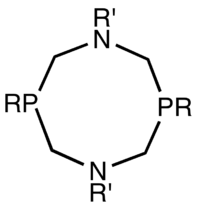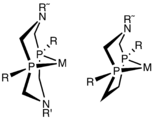1,5-Diaza-3,7-diphosphacyclooctanes
1,5-Diaza-3,7-diphosphacyclooctanes are organophosphorus compounds with the formula [R'NCH2P(R)CH2]2, often abbreviated PR2NR'2. They are air-sensitive, white solids that are soluble in organic solvents. The ligands exist as meso and d,l-diastereomers, but only the meso forms function as bidentate ligands.[1]

Some metal-PR2NR'2 complexes catalyze the production and oxidation of hydrogen (H2). The catalytic mechanism involves the interaction of substrate with the amines in the second coordination sphere.[2][3]
Synthesis and reactions
The ligands are prepared by the condensation of a primary phosphine, formaldehyde, and a primary amine:
- 2 RPH2 + 4 CH2O + 2 RNH2 → [RNCH2P(R')CH2]2 + 4 H2O
Diazadiphosphacyclooctanes function as chelating diphosphine ligands. Typical nickel complexes contain two such ligands are give the formula [Ni(PR2NR'2)2]2+.
Cationic complexes of these P2N2 and related ligands often exhibit enhanced reactivity toward H2. These complexes serve as electrocatalysts for H2 production.

Related ligands
Azadiphosphacycloheptanes are a related family of diphosphines, but containing only one amine. They are prepared by condensation of 1,2-bis(phenylphosphino)ethane, formaldehyde, and a primary amine.[4] From the meso-isomer, typical nickel complexes contain two such ligands, i.e. [Ni(PR2NR')2]2+. When bound to metals, these ligands adopt a conformation similar to that of 1,4-diazacycloheptanes. Acyclic phosphine-amine ligands have the formula (R2PCH2)NR'.
References
- Erika Bálint; Adám Tajti; Anna Tripolszky; György Keglevich (2018). "Synthesis of platinum, palladium and rhodium complexes of α-aminophosphine ligands". Dalton Trans. 47 (14): 4755–4778. doi:10.1039/C8DT00178B. PMID 29565437.
- Yang, J. Y.; Chen, S.; Dougherty, W. G.; Kassel, W. S.; Bullock, R. M.; DuBois, D. L.; Raugei, S.; Rousseau, R.; Dupuis, M.; Rakowski DuBois, M. (2010). "Hydrogen oxidation catalysis by a nickel diphosphine complex with pendant tert-butyl amines". Chem. Commun. 46 (45): 8618–8620. doi:10.1039/c0cc03246h. PMID 20938535. S2CID 34168725.
- Bullock, R. M.; Helm, M. L. (2015). "Molecular Electrocatalysts for Oxidation of Hydrogen Using Earth-Abundant Metals: Shoving Protons Around with Proton Relays". Acc. Chem. Res. 48 (7): 2017–2026. doi:10.1021/acs.accounts.5b00069. OSTI 1582563. PMID 26079983.
- Karasik, A. A.; Balueva, A. S.; Moussina, E. I.; Naumov, R. N.; Dobrynin, A. B.; Krivolapov, D. B.; Litvinov, I. A.; Sinyashin, O. G. (2008). "1,3,6-azadiphosphacycloheptanes: a novel type of heterocyclic diphosphines". Heteroatom Chemistry. 19 (2): 125–132. doi:10.1002/hc.20397.